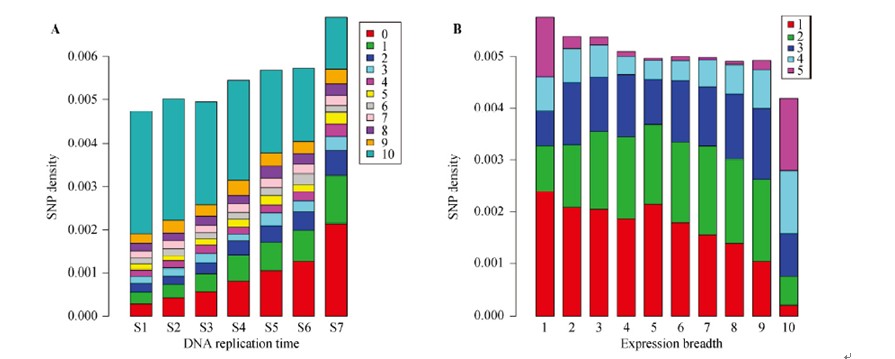DNA Replication and Transcription Distinctly Influences Mutation Rate Variation
There are two dominant mechanisms responsible for mutation in human genomes—DNA replication and transcription. A research group led by Prof. YU Jun at Beijing Institute of Genomics (BIG), Chinese Academy of Sciences(CAS) revealed distinct contributions of replication and transcription to mutation rate variation of human genomes.
To explore the relationship between gene mutation rate and tissue specificity, Dr. CUI Peng et al examined the expression breadth of 17,288 human genes across 10 tissues. They observed significantly higher SNP density in tissue-specific (TS) genes than housekeeping (HK) genes. TS genes tended to locate in late-replicating genomic regions and interestingly, a higher SNP density was found in genes located in these regions compared to those in early-replication regions. Meanwhile, they also showed that SNP density was positively correlated with expression level among HK genes.
Prof. YU and his colleagues concluded that compared to the transcription-associated biological processes which are mainly responsible for the accumulation of mutations in highly-expressed HK genes, the process of DNA replication generates stronger mutational pressure, thus leading to higher mutation rate in TS genes while having modest influence on HK genes.
These results were published in Genomics, Proteomics & Bioinformatics (GPB), Volume10, Issue1.

Replication timing, SNP density, expression breadth and expression levels of human genes. A. Average SNP density is significantly correlated with the progression of DNA replication (Spearman ρ=?0.26, P<0.001). B. The widely-expressed genes show higher expression levels. (Image by CUI Peng et al.)
Paper Link: http://www.sciencedirect.com/science/article/pii/S1672022911600284
Contact: Prof. YU Jun Email: junyu@big.ac.cn